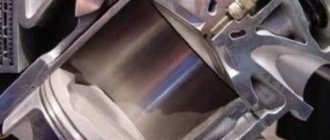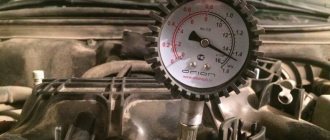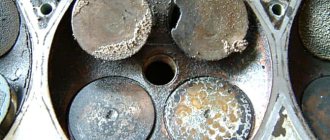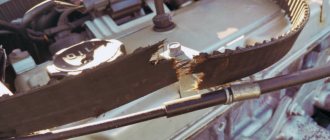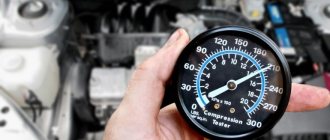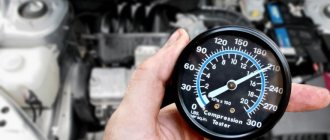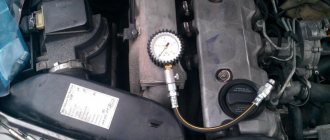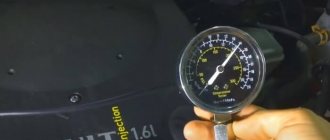For most experienced car enthusiasts, it is well known that the ease of starting the internal combustion engine, as well as the stability of the further operation of the power unit, directly depends on the compression ratio in a gasoline or diesel internal combustion engine. Compression also greatly affects power, fuel and engine oil consumption, as well as the life of the power plant.
As a rule, many drivers and auto mechanics, during superficial diagnostics, identify a number of breakdowns and determine the general condition of the engine precisely by the compression indicator. At the same time, measuring compression in the engine is not difficult. This operation is easy to implement in a regular garage; the engine does not need to be disassembled, and no special tools or equipment are required.
It is enough to unscrew the spark plugs on a gasoline engine or the glow plugs on a diesel engine, after which a compression gauge is installed through an adapter into the spark plug wells. Then the engine is cranked from the starter, measuring the compression readings in each cylinder and comparing them with the norm for a particular type of internal combustion engine.
However, although measurements are relatively easy to take, accurately determining the cause of deviations from the norm is much more difficult, since compression can be low or high for a variety of reasons. Next we will talk about why increased compression occurs in the engine, and why it can also decrease.
Compression End Pressure
Compression is a popular expression, the correct term is “compression end pressure.”
It is created in the cylinder by the movement of the piston when the ignition is turned off and without fuel supply. To measure the pressure in the cylinders, technicians in technical services usually use a special device - a compression meter, which is screwed in instead of a spark plug. The measuring element is inside the cylinder. Next, the crankshaft is spun by the starter, and the arrow shows a certain value on the scale.
The higher the compression, the more power the power unit can develop. It depends on the condition of the piston rings and their degree of wear. The valve plates gradually burn out, do not fit tightly into the seat and allow gases to pass through. A “stuck” valve or a burnt-out piston does not allow the required pressure to be created in the cylinder.
If they are damaged, gases penetrate into the crankcase, the engine cannot develop its designed power, and its characteristics are distorted. If in one cylinder the compression is 25% lower than in the others, then engine repair with complete disassembly is necessary.
Normal compression values for common 1.6-liter naturally aspirated engines are considered to be 11-12 bar. In old VAZ carburetor engines, the minimum threshold is 10 bar. A new unit in excellent condition should show 13 bar just off the assembly line.
It is impossible to increase compression indefinitely due to the risk of detonation. The air-fuel mixture heats up during compression and can ignite randomly even before the compression cycle is completed. That is, the mixture will explode ahead of time, causing damage to engine parts.
How compressible is the fuel?
At the dawn of the automotive industry, the compression ratio of Otto engines was 4-5 units. On old VAZ carburetor engines, the fuel-air mixture was compressed 9.5-10 times. On injection engines - 10.5-11 times. Now on modern turbocharged units it is compressed by 12-14 times. But it is impossible to do this indefinitely. Construction costs are rising.
In general, compression and compression ratio are not the same thing. But both of these quantities affect the engine power. True, as pistons, valves and rings wear out, compression may drop, but the compression ratio never does.
What factors influence compression?
The fuel cylinder is a working chamber of volumetric displacement. It is a closed-type system consisting of a large number of parts:
- valves;
- cylinder head;
- piston and rings;
- cylinder walls.
Each element affects the performance of the system. If one of them is damaged or severely worn, the pressure decreases. A cracked piston will lead to exhaust gas leakage. This will have a bad effect on power characteristics.
The pressure level often decreases due to damaged or dirty rings. Incorrectly set valve timing, low-quality composition of the working mixture, and an incorrect injection timing angle also cause the formation of carbon deposits in the valves. This ultimately leads to loss of pressure and further problems.
Layered Friction Modifiers
Layered friction modifiers - the composition includes compounds of molybdenum, tungsten, tantalum, graphite, etc. The operating principle is to form a layered surface layer on the friction surfaces with a low shear force and, therefore, a low coefficient of friction.
The disadvantages are so great that we will skip the pros:
- the friction reduction effect is not sustainable;
- the coating is not durable, and a decrease in the concentration of the drug in the oil quickly negates the effect of the treatment;
- high rate of decomposition of sulfur compounds at high temperatures, which increases the corrosive activity of engine exhaust gases;
- graphite, which is part of some drugs in this group, has a tendency to deposit in piston grooves, oil channels and on valves, which, with prolonged use of the drug, leads to the closing of the gaps in the piston rings and their occurrence, or the valves “hanging” in the guide bushings.
Well-known manufacturers: Xenum, Liqui Moly.
Standards and norms
There is an opinion among owners of modern cars that the compression of a hot engine can be from 8 to 10 atm.
The compression rate in the cylinders of any engine is from 12 atm, with rare exceptions.
Cars use engines of various configurations, determined by the number of valves and camshafts, the geometry of the intake manifold, and the installed connecting rod and piston group. In accordance with this, its specific compression ratio is calculated - this is the ratio of the total volume of the cylinder to the volume of the combustion chamber.
The higher the compression ratio, the higher the compression value. For gasoline engines, the compression ratio is in the range of 8 - 12 units, which is indicated in the technical documentation of a particular car. Theoretically, it is not difficult to determine what the compression in the cylinders should be for a particular engine. It is enough to multiply the compression ratio by a factor of 1.3.
For example, the compression ratio in the car’s characteristics is indicated as 9.5 units, multiplying 9.5 by a factor of 1.3 to obtain a calculated value of 12.35 atm.
What's the result?
As you can see, a high compression ratio in a gasoline engine or diesel device is no less a problem than a low compression ratio. In addition, in this case, the engine consumption also increases significantly, since increased pressure occurs in the cylinders. In this situation, important parts and assemblies begin to feel significant stress.
The most important thing to understand is that high or low compression is not a cause of failure, but a consequence of existing problems. To save engine resources and reduce its consumption, it is necessary to carry out comprehensive diagnostics and repairs and thus quickly bring the compression indicator to the calculated standard.
In conclusion, if the compression value has changed, you should find the reason as soon as possible to prevent more serious consequences, especially for high compression. High compression ratio can damage the cylinder head, empty valves, etc. Which significantly increases the overall costs of subsequent engine repairs.
Compression testers
A compression gauge is a device consisting of a pressure gauge with a scale, a pressure relief valve and tips. The most convenient is a flexible hose with a threaded end, in which a nipple is installed to prevent air from escaping back out of the device. Checking compression in engine cylinders that include spark plug wells in their design is carried out by screwing a flexible hose into the threaded hole of the spark plug, which eliminates the loss of compressed air from loose fitting of rigid tips without threads.
What should you measure?
To assess the technical condition of the cylinder-piston group and the tightness of the valves, a diagnostic device is used to measure compression. The kit includes the following parts:
- dial pressure gauge with a scale of 0–2.4 MPa (for diesel – 0–4 MPa);
- a flexible pipe with a tip that is screwed into place of the spark plug;
- Check Valve;
- manual air release valve;
- nozzles - adapters for various threads.
The simplest version of a compression gauge is a pressure gauge with a check valve and a rubber nozzle in the form of a cone. During the measurement process, the device must be pressed against the spark plug hole and held by hand, and not screwed in.
If the purpose of the pressure gauge is clear, then the functions of the remaining elements require explanation. The check valve prevents air from leaving the device body while the piston pumps up maximum pressure, which occurs in 5–10 strokes. The readings are then reset to zero by releasing the air using the button. Since compression in a diesel engine is measured through holes for injectors or glow plugs, the device is equipped with various adapters.
How often to check compression
For prevention, diagnostics are carried out when replacing spark plugs. This procedure should be carried out every 25-50 thousand km.
In addition, emergency diagnosis is carried out for the following signs:
- The engine consumes a lot of oil - more than 200 ml per 1000 km.
- Blue smoke comes out of the exhaust pipe.
- The car has become harder to start in winter.
- Unstable idle, vibration.
The last symptom indicates a failure of the ignition system or several spark plugs. Before measuring compression, these faults must be eliminated. On diesel engines, wear of valves, pistons and cylinders shows the same signs. Cold starts are especially noticeable - diesel fuel cannot ignite.
What to do if diagnostic results are disappointing
When the pressure in one or more cylinders deviates from normal, you are dealing with a malfunction of the power unit. As a rule, such problems require partial or major repairs of the “heart” of the machine. If the indicators are too low, the following breakdowns are possible:
- Wear of rings, pistons and liners (with the same values on all cylinders). The “diagnosis” can be clarified if a second measurement is taken with the addition of 4-5 ml of motor oil to the cylinders. Increasing the compression will confirm the result. If the readings do not change, then the following problem occurs.
- The presence of leaky valves in the chambers (at different values).
- One of the valves or pistons is burnt out (no pressure at all).
Piston burnout in the center (left) and side (right)
A pneumatic tester can provide more accurate results. The breakdown is detected as follows: if air goes into the crankcase, then the pistons pass, and if it goes into the manifold, the valves. Malfunctions associated with a drop in compression below normal are eliminated by disassembling the power unit and replacing worn parts. There is no point in changing one valve, since over time the next one will fail. It is better to install a new valve group.
The same applies to pistons - a set is installed at once, and the parts are selected by weight so that the difference is no more than 5 g. Fitting is done by removing a thin layer of metal from the inside of the heaviest pistons with a scraper. If, after removing the block head, the measurement showed a large ellipse-shaped hole in the cylinders, then they should be bored on a machine to the next repair size.
In many foreign-made engines, the installation of repair parts is not provided. There you need to change the entire set at once - liners, pistons and rings.
If you do not respond to a drop in compression below normal in a timely manner, the consequences may be as follows:
- cold starting the engine will become more difficult, and then completely impossible, without injecting oil into the cylinders;
- consumption of motor lubricant due to waste will increase to 1-1.5 liters per 1000 km, which may cause spark plugs to fail and rings to become coked;
- due to the large difference in compression in the cylinders, the engine will operate unstably and vibrate;
- fuel consumption will increase significantly;
- the power of the power unit will drop to such an extent that driving will become impossible.
This is what a burnt valve on the side looks like
The reason for excessive compression is the presence of motor oil in the combustion chambers in large quantities, which leads to compaction of all gaps. The problem arises due to unsuitable oil reflecting caps, when lubricant enters the chambers not from below, but from above, through the valves. This problem is considered relatively harmless: oil deflectors are replaced in 2-3 hours, depending on the make of the car.
Compression measurement continues to be one of the simplest and fastest methods for diagnosing power units. When engine problems occur, the first thing you need to do is check the pressure. And based on the test results, you should decide on the further sequence of actions: carry out more in-depth diagnostics or disassemble and repair the motor.
Symptoms of low engine compression
Actually, we have already talked about the signs of decreased compression in car engines. Another thing is that the car can trip and shake for other reasons, with engine compression, which have nothing to do with it. However, if the engine begins to consume oil, if its operation has become unstable, and even for no apparent reason, you should measure the compression in the cylinders of your car. Also, a decrease in compression can be caused by a drop in traction, an increase in fuel consumption and an increase in vehicle acceleration time. As for the difference in compression in different cylinders of the same engine, as long as this value does not exceed one atmosphere, there is no problem. If the difference is greater, the motor should be repaired.
Danger of vibrations
The causes of vibrations that occur must be eliminated as soon as possible after the first signs of problems occur. This is explained by the fact that after vibrations, other problems often develop that can cause enormous damage to your vehicle. As experts themselves note, the greatest damage due to vibrations is caused to the car body. The first to wear out and break are the plastic elements, then gradually all sorts of fastenings, located sometimes in very hard-to-reach places, become loose. When the car shakes for a long time, the paint layer may begin to deteriorate. This already entails the formation of corrosion and the spread of rust throughout the body.
We must not forget about the harm that is caused to the power unit. The engine also suffers significantly from unnecessary vibrations. Vibration causes accelerated wear of parts, destroys the packing in the crankshaft, and then oil begins to leak. As a result, the engine cannot produce the required number of revolutions, the car accelerates more slowly, and fuel consumption increases significantly. And at the same time, engine power decreases, which negatively affects control. If you noticed that the car began to vibrate, but were able to find the reasons and eliminate them, the work is not yet completed. In addition to this, be sure to check all the parts that could have been damaged in any way as a result of the vibrations that have arisen. You can eliminate the source of vibration, but you cannot exclude the fact that some destructive processes have already been launched. The fastener has come loose, the paintwork has been damaged, and therefore new problems will potentially arise soon.
High compression in the engine
So, as mentioned above, compression in the power unit can be influenced by a number of factors. Let's start with increased compression. First of all, increased compression usually indicates that there is a problem with the engine. As a rule, the main symptom is unstable engine operation, discoloration of the exhaust and increased oil consumption.
Typically, in many cases, car enthusiasts are faced with so-called “oil” compression, when general engine coking and problems with oil scraper rings lead to excess oil and carbon deposits actually reducing the volume of the combustion chamber. The result is an increase in compression.
In other words, an increase in compression is caused by carbon deposits on the timing valves, the accumulation of coke in the combustion chamber and the occurrence of oil scraper rings. A common cause is also engine overheating, when oil loses its properties due to high temperatures and quickly contaminates the combustion chamber.
Other reasons include the use of additives in the lubrication system, pouring inappropriate or low-quality oil for the engine, constant operation of the engine on low-grade fuel, etc.
One way or another, the accumulation of coke and soot leads to a decrease in the volume of the combustion chamber in which the fuel-air mixture is compressed. Naturally, in this case, when taking measurements, the compression meter will show too high a compression.
Let us also add that deviations from the norm can be caused by incorrect installation of valve timing. Simply put, errors when aligning the pulleys when replacing a timing belt or chain will lead to the drive element jumping several teeth (on an internal combustion engine with a belt) or links (on chain engines) forward or backward.
To avoid possible problems, it is necessary to pay special attention to the location of the marks on the pulleys, engine housing, etc., that is, set the timing drive, and also correctly tension the chain or belt.
Also, the cause of high compression may be a combination of problems with valve stem seals and rings. If, after unscrewing the spark plugs in the cylinders, a clear excess of oil is visible in the form of a thick oil film on the cylinder walls, then this clearly indicates the need to replace the valve seals.
If we summarize the information why increased compression occurred in the engine, the reasons are as follows:
- there is a lot of oil in the engine cylinders (rings are stuck, valve seals are worn, etc.);
- change in the volume of the combustion chamber as a result of the accumulation of deposits and soot, as well as engine overheating and deposits of burnt oil;
Let us also add that compression is affected by air temperature and the condition of the air filter. When taking measurements, it is advisable to disconnect the air filter. It is also important to understand that at many service stations, compression gauges have a large error.
In practice, this requires several repeated measurements on a hot engine, preferably with different and pre-calibrated instruments. There have been cases when at one station the driver’s compression was determined after measurements, for example, 12.5-13, and at another service the readings for all cylinders were already about 16.
To solve the problem of high compression, you can use several available methods. The first is disassembling the engine, physically cleaning the pistons and combustion chamber from carbon deposits, replacing rings, valve stem seals, etc. A cheaper and less effective solution is to decarbonize the engine. In a nutshell, an active cleaner is poured into the combustion chamber for a certain time to remove carbon deposits and coke, after which the deposits washed off the walls and surfaces then burn out while the engine is running.
Motor repair or replacement with a contract one?
In general, any malfunctions that lead to a decrease in compression in the engine cylinders can be eliminated. If the problem lies in the valves/cylinder head, then repair and restoration will cost 300-600 rubles. A liner for one cylinder will cost 80-120 rubles. If the pistons are damaged, they must be replaced. The price of the issue varies greatly depending on the engine and piston manufacturer. For example, for TFSI engines that suffer from oil burns, a Kolbenschmidt piston costs about 200 rubles, and the original costs 650 rubles apiece (these pistons come complete with all rings).
To these amounts should be added the costs of removing and installing the motor, disassembling and reassembling it. As a result, it turns out that the overhaul of the 2-liter TFSI/TSI engine, which is popular in terms of CPG problems, will cost about 3,600 rubles. This is if you change all four pistons. A contract engine costs from 2,500 to 3,000 rubles (plus replacement work, as well as consumables - 1,000 rubles). In this case – and we are talking about TFSI/TSI engines – many people go for a major overhaul, during which they install modernized pistons, with which the problem of “oil leakage” disappears.
Also, owners of cars whose engines chronically suffer from CPG wear: the appearance of scuffing on the cylinder walls also undergo major repairs with the block liner. This applies to many gasoline engines from BMW, Mercedes (and the Audi/VW engines mentioned above), as well as the widespread G4KD/4B11 engine (Kia, Hyundai, Mitsubishi), which is practically not offered in disassembly shops. Here it is advisable to solve the problem once and for all.
If the compression problem is associated with cylinder head wear, then you can also safely consider the option of restoring it. The work will cost, as we mentioned, 300-600 rubles, plus about 200-400 rubles for its removal and installation with replacement of the gasket.
In a large number of other cases, if a decrease in compression was caused by an accident, maintenance errors or huge mileage, you can safely consider the option of replacing the engine with a contract one. Motors that are not in great demand will cost 1000–2000 rubles, plus about 600–1000 rubles for removal and installation with oil change and necessary consumables.
Hi all! The situation is this: about 2 weeks ago, standing in a traffic jam on the way to work and looking at the car in front, I noticed that the low beam was flickering slightly. Then I didn’t attach much importance to it, I just decided to observe. A couple of days later, when I arrived home and parked, I turned on the interior lamp to illuminate the frame of the radio. which I was going to remove in order to later dismantle the radio and extend the AUX to the plug next to the cigarette lighter. So, when I turned on the lamp, I discovered that the light was not even, but flickering. I got out of the car, looked at the front dimensions - it was the same story. Then I discovered another interesting point. If on a warm car in neutral you spin the engine at 1100-1150 rpm, you will feel vibration on the steering wheel, seat... and in general on the body. And if you briefly raise the speed in neutral on a cold car, it continues to shake at idle. At the same time, when the car warms up after parking overnight, for example, the following sounds are heard from the exhaust pipe:
But I tried to remove the flickering of the light, but the vibration in the cabin is more visible when it’s cold:
As a result, I made an appointment with the OD and arrived. They held an interactive reception. They confirmed that this is not my invention and, indeed, there is a place for unstable engine operation. It was decided to measure the compression. After 20 minutes everything was ready:
1 — 13.4 2 — 15.0 3 — 14.2 4 — 14.9
Those. The compression is clearly increased. I already measured the compression a little less than a year ago and then these figures were about 3 less for each cylinder. The verdict was reached - the crankcase ventilation valve
, namely, a torn membrane. Well, there’s nothing to do, it’s undesirable to drive like that, and I agreed to replace it - fortunately I have discounts there and the price for the part will not differ from the price at the same existential, for example. I ordered and paid for everything on Friday, and a replacement arrived on Monday morning. An hour and a half later, after I dropped off the car, they called me back with the news that everything was ready, come over. I picked up the car at lunchtime. And the first thing I noticed was that the vibration when picking up speed in neutral was and remains. The mechanic responded to my complaint: I wasn’t the one who carried out the diagnostics, that technician will come out on Wednesday, if you want, leave the car. And in general, the oil just has to burn out from the cylinders... In short, I decided to pick up the car and think about what to do next. The phrase “not much should burn out of the cylinders” somehow did not convince me and even outraged me. How much oil should there be?) If it is there, it will burn out in 5 minutes of driving, but they told me to drive 500 km... So in the end I sit and think what to do and what could be the reasons for all this disgrace. Since excessive compression has been detected, options with crankcase protection supporting the engine, a dangling exhaust system, and an engine mount that has failed should seem to disappear. Next, you can consider gasoline and oil. I just changed the oil from Castrol 5w30 to the original SPECIAL PLUS 5W-40 and have already driven 8 thousand on it. I also started refueling at a BP gas station closer to home (previously I refueled at a gas station on the way out of Moscow), i.e. A purely theoretical reason can be found here.
Here are the questions running through my head right now: But what other options could there be and how to diagnose them?
Is it possible to drive with increased compression and what consequences does this have for the engine? Has anyone encountered this problem on a Polo Sedan?
The engine pulls confidently, there seems to be no jerking during acceleration. Fuel consumption is as usual (I do not observe an increase in consumption).
Reasons for low compression
As mentioned above, a decrease in compression occurs for several reasons, these are:
- engine service life;
- violation of maintenance (delayed oil change);
- use of low-quality oil;
- engine overheating;
- Driving with a cold engine (thermostat malfunction).
There are also reasons when additives will not help and repairs are needed, these are:
- piston burnout;
- valve burnout;
- burnout of the gasket between the cylinders;
- rings are stuck (sometimes “cured”).
Burnt out piston
Faults such as burnout are almost immediately noticeable, but some can only be determined after diagnosis.
Permissible compression difference in cylinders
If the measured compression differs between cylinders, this complicates matters. The engine will have to be disassembled and overhauled. Not only will it be necessary to replace rings, valves and sealing caps.
Compression less than the minimum value in one cylinder means that there are defects in the piston or cylinder. In this case, all elements of the cylinder-piston group are usually changed, otherwise the difference in compression will remain and the problem will not go away.
The normal value is considered to be a pressure of 10-12 bar, depending on the car model and engine. But the permissible difference in compression in different cylinders has also been established. For example, in cylinders 2 and 3 this value may be 0.5 bar lower, which is quite acceptable. It depends on the load on the pistons - where there is more, there is more wear.
Advice! If the pressure in different cylinders differs greatly, for example, by 3 or 4 atmospheres, then this is abnormal. The motor will run intermittently. This can happen in several cylinders at once, which brings a major overhaul closer.
Compression and throttle
The throttle position changes the compression ratio, so to accurately diagnose the problem, first measure with the throttle fully open and then with the throttle closed.
Closed damper
In this case, a small amount of air will enter the cylinder. The pressure at the end of the compression stroke will be lower. This test allows for a fine diagnosis of faults. Here's what low compression can indicate when the throttle is closed:
- Valve stuck;
- Worn camshaft cam>;
- The valve does not fit tightly to the seat;
- Crack in the cylinder wall;
- Blown cylinder head gasket.
Such problems may arise as a result of natural wear and tear on certain parts. Sometimes such malfunctions are the result of poor-quality engine repairs.
Open damper
In this case, more air will enter the cylinder, so the pressure at the end of the compression stroke will be noticeably higher than when measured with the damper closed. For minor leaks, the indicator will not differ much. In view of this, such diagnostics makes it possible to identify more severe defects of the CPG. Possible malfunctions include:
- The piston burned out;
- The rings are coked;
- The valve has burnt out or its rod has become deformed;
- The ring has burst or become deformed;
- Scores have formed on the cylinder wall mirror.
The dynamics of increasing compression are also important. If it is small during the first compression, and then jumps sharply during the next compression, then this may indicate possible wear of the piston rings.
On the other hand, a sudden formation of pressure during the first compression, and not changing during subsequent ones, may indicate a violation of the tightness of the cylinder head gasket or valve. The fault can only be accurately determined using additional diagnostics.
If the car owner decides to use both methods of measuring compression, then the procedure should first be performed with the throttle valve open. Then you need to screw in the spark plugs and let the engine run. Then the pressure is measured with the valve closed.
Poor engine compression. What can it lead to?
Low engine compression levels are always a reason to be wary, because this can cause serious problems in the operation of the engine. One of the common manifestations of low air pressure in the engine is a reduced amount of oil in the engine. This is followed by difficulties when starting the engine, increased fuel consumption, and the engine may begin to stall. What is the reason for low compression? Now I'll try to tell you.
Engine overheating
The first reason is overheating of the power unit. If the temperature reaches a critical maximum, then irreversible processes occur inside the engine. If the cylinders overheat, the pistons and rings may burn out. It happens that the piston completely burns out, compression drops and the engine fails.
Problems in the gas distribution system
The gas distribution system is responsible for the intake and exhaust of engine exhaust gases. If the valve adjustment is incorrect, this may be one of the reasons for low compression. It is also worth paying attention to the timing marks, which may not be lined correctly.
Worn piston rings
When using a car, natural wear and tear occurs. Any part wears out, the only question is when it wears out. It’s more difficult with rings, because they are not visible. If they are too worn, this will affect engine compression. However, do not forget that correct operation of the car, according to the manufacturer’s recommendations, is the key to long-term operation of the engine.
Exceptions to the rules: when you have to measure pressure on a cold engine
Sometimes it is necessary to evaluate the condition of the CPG and valves under exceptional conditions. For example, on a “cold” engine, compression measurement is carried out if:
- the car does not start initially;
- the power unit has been removed from the vehicle;
- There are doubts that there is enough pressure to start.
A separate case is checking a dismantled engine. At dismantling sites, you often find units in excellent condition that can serve the next owner for a long time. Before purchasing a motor, the condition of the CPG is diagnosed. If the assembly is removed along with the starter, compression is measured in the usual way, only “cold”. To rotate the crankshaft, you need to connect a working battery to the unit, and check the pressure with a compression gauge.
A CPG without a starter is tested with a pneumatic tester. This device is a manifold with an air regulator and two pressure gauges connected to the compressor by hoses. The principle is simple: air is supplied to the cylinder at a certain pressure, which is displayed on the first pressure gauge. The second device shows the total amount of leakage through leaks in valves and pistons. If the loss value is within the normal range, the engine can be purchased.
Do-it-yourself compression measurement
To measure the compression, you can, of course, contact a car service. But it’s easier to save money and measure yourself. For such measurements, it is enough to simply buy a specialized device - a compression meter. This is essentially a pressure gauge, but with a check valve that measures the maximum pressure in the engine cylinder.
Currently, the market offers compression meters for diesel and gasoline engines. The differences are in the permissible measurement limits, because in diesel engines the pressure is much higher.
To check the compression, we first need:
- checking the battery charge level. This is necessary because, when measuring pressure, the engine will run on the battery.
- warm up the car engine to operating temperature. This is necessary to obtain the most accurate measurement results.
Then we move on to the second stage:
- removing all spark plug wires;
- unscrewing the spark plug of each cylinder;
- with an electric fuel pump, it must be pulled out. If the fuel pump is normal, then the hose responsible for fuel is simply turned off;
- disconnecting the power wire from the injectors if necessary.
Having completed these steps, you can proceed directly to measuring the compression in the engine cylinders. It is advisable to carry out measurements together, so that one person records the measurement results and the other rotates the motor.
To measure, perform the following steps:
- screwing the compression gauge into the cylinder being tested;
- pressing the gas pedal all the way to fully open the throttle. The ignition key begins to rotate the starter. The rotation is carried out until the indicator of the device stops increasing - this will be the engine compression.
After the result obtained, it is necessary to compare it with the standards that should be for this engine. If the results are close to the norm, then the compression in the engine is good and the engine is running perfectly, or this is not the cause of the engine failure.
Video: features of checking engine compression
The channel “ICE Theory” in the video spoke in detail about the nuances of checking the pressure in the engine cylinders and showed the process in practice
Conditions for successful measurement
To successfully diagnose a gasoline engine, the following conditions should be organized:
- the engine is warmed up to an operating temperature of 70-90 ° C;
- the battery is charged and the starter easily rotates the crankshaft;
- fuel supply is turned off;
- spark plugs are unscrewed.
For the procedure, you need to attract an assistant who will turn on the starter and press the gas pedal to ensure air supply to the cylinders.
On a gasoline engine, you need to unscrew the spark plugs.
Before unscrewing the spark plugs, it doesn’t hurt to blow out their wells to avoid dirt getting into the combustion chambers. Instead of spark plugs, the tip of a compression gauge is screwed into the holes one by one. Another way is to press the device against the hole manually, after putting on a rubber cone.
Unlike a gasoline unit, a diesel engine should be checked in a cold state, since its successful starting largely depends on the presence of compression. You will have to screw in the tip instead of the dismantled injectors or glow plugs - for this you need to use the appropriate adapters from the kit.
Analyzing the results obtained
Analysis of the results obtained comes down to comparing the pressure gauge readings in all cylinders. It is worth paying attention to the cylinder whose pressure level differs from the pressure readings in other cylinders; it can be either less or more.
If the difference in readings does not exceed one atmosphere, then there is no point in sinning on the CPG. Return to diagnosing the car's ignition system, check the spark plug. Also check the fuel supply to the cylinders.
Indications in more than one atmosphere are also typical for cars with a mileage of more than 50 thousand km.
The reason for the distinctively higher pressure in the cylinder may be the presence of a large amount of oil in it, the cause of which must be clarified separately. Turn out the spark plug and see if it is in oil, then this is our case.
Compression measurement of gasoline and diesel engines
Compression measurements on gasoline and diesel engines are different. In the first case, the procedure is much easier than in the second. The difference is this.
The procedure for taking measurements
Before checking engine compression, it is necessary to ensure that the battery is fully charged and the starter is working properly. Otherwise, you will get underestimated indicators and start repairing the power unit instead of continuing diagnostics and looking for other reasons.
There are several ways to measure pressure - “cold”, “hot”, with the throttle closed and fully open. Practice shows that the most accurate results are obtained by checking on a warm engine, performed according to the instructions:
- Start the engine and bring the coolant temperature to 70 °C.
- Remove the high-voltage wires and turn out all the spark plugs and, on a diesel engine, the injectors.
- Disconnect the injectors from the controller by disconnecting the corresponding connector. Another option is to turn off the power to the fuel pump by removing the required fuse.
- Screw the compression gauge nozzle into the hole of the 1st cylinder, open the throttle valve by pressing the gas pedal, and turn the crankshaft with the starter 5–10 times.
- Take readings and repeat the operation on the remaining cylinders.
If you do not want to touch the electronics, then you don’t have to turn off the injectors of the gasoline engine; this will not affect the accuracy of the readings, but during diagnostics a small amount of fuel will enter the oil sump. The fuel supply on a diesel engine with a mechanical injection pump is turned off using the cut-off lever.
Based on the measurement results, the following conclusions are drawn:
- If the measurement values differ by no more than 1 bar and are close to optimal, the piston group and valves are in good condition.
- The same situation, but the indicators are close to the minimum threshold. The resource of the power unit is almost exhausted, you can drive further and add oil, but prepare for repairs.
- When the pressure in one of the cylinders is 2-3 bar lower than the others, check again by pouring 5 ml of engine lubricant into the spark plug hole. If the compression has increased, this means that the piston group is faulty, since the oil has sealed the fit of the rings. The readings remained the same - a burnt valve was to blame.
If the pressure in all cylinders is below normal, a major overhaul will have to be done. It is useless to carry out a test with adding oil - the engine still needs to be disassembled.
How to determine compression on a diesel engine
The process of measuring compression on a diesel engine is no different from diagnosing a gasoline power unit, only the readings from the device will be higher. The difference lies in the preparation, at the stage when it is necessary to cut off the flow of fuel. Depending on whether the car has an old mechanical pump or a new electric injection pump, the fuel supply must be turned off in one of the following ways:
- On mechanical injection pumps (high pressure pumps), a shut-off lever should be used to shut off the fuel. Then you need to disconnect the fuel line.
- Electric pumps are de-energized by removing the fuse or disconnecting the connector.
It is better to check a diesel engine “cold”. If the device shows pressure below 22 Bar, it will be difficult to start the engine, especially in winter. To start diesel engines with an unsuitable piston group, a radical method is used - pouring 4-6 ml of oil into the cylinders, which helps seal the gaps and increase pressure.
Gasoline engine
The pressure in this case will be measured through the spark plug holes. It is easier to measure compression yourself if you have good access to the spark plugs. To carry out the procedure, a conventional compression meter is sufficient.
Without compression gauge
If the driver does not yet have a personal compression gauge in his toolkit, then you can check the pressure without it. Of course, this method is inaccurate, and this indicator cannot be relied upon to determine what condition the engine is in. Rather, it is a method that will help determine whether the loss of power was due to a motor malfunction or not.
To determine whether sufficient pressure is created in the cylinder, one spark plug is unscrewed, and a wad made of dry newspaper is inserted in its place (a rag gag is not suitable). Under normal compression, when the crankshaft is cranked, the gag should shoot out of the spark plug hole due to high pressure. A loud bang will sound.
If there are problems with pressure, the wad will still jump out of the well, but there will be no pop. This procedure should be repeated with each cylinder separately. If in any of them the gag did not pop out so “spectacularly,” then the car needs to be taken to a mechanic.
Using a compression gauge
In the classic version, compression measurements at home are carried out using a compression meter. To do this, the engine warms up. Then all the spark plugs are unscrewed, and instead of them, using an adapter, a hose connected to a pressure gauge is screwed into the spark plug well (if a pressure gauge is used, it must be inserted tightly into the hole and held so tightly that air does not leak out of the cylinder).
An assistant must depress the clutch pedal (to make it easier for the starter to rotate the flywheel) and gas pedal (to fully open the throttle). Before measuring compression, an assistant tries to start the engine to remove soot and deposits from the cylinder.
The starter is turned under gravity for about five seconds. Usually this time is enough for the pressure gauge needle to rise and stabilize.
Recovery methods
To increase the compression in the engine, if you are sure or suspect that the rings are stuck, you can pour 100 grams of clean oil into each and give them time to “throw away”. Sometimes turning the crankshaft in both directions a few degrees. The procedure can be repeated.
The second, more effective method, you need to take: 1 part clean motor oil, 1 part acetone and 1 part kerosene. Stir and pour 50 ml into each cylinder, tighten the spark plugs and leave for 10 hours. Unscrew the spark plugs and crank the engine with the starter for a few seconds. We install the spark plugs, start it and heat it up to 40 degrees no more. Drain the oil, flush the system, change the filter and fill in new oil.
There are also special means that are also used to combat increased compression, which occurs when there is more carbon deposits on the piston and in the combustion chamber.
The second method is to restore pressure by adding additives to the oil. There are quite a lot of them on the market with varying effectiveness. I wrote about the use of the Suprotek additive, the effect of its use is positive.
Table: What should be the compression of cars
Car Compression, kg/cm2
| VAZ 2106-07 | 11 |
| VAZ 2109 | 11 |
| VAZ 2110 | 13 |
| Audi A4 (2011-2021) 1.8-2.0/3.0 | 12/12.5 |
| Chevrolet Cruze 1.6/1.8 | 14/13 |
| Chevrolet Lanos 1.5 | 12 |
| Chevrolet Lacetti 1.6/1.8 | 12/12.5 |
| Chevrolet Aveo 1.6 | 13.5 |
| Daewoo Gentra 1.5 | 12.5 |
| Daewoo Matiz 0.8 | 11 |
| Daewoo Nexia 1.5/1.6 | 10.5/11 |
| Ford Focus (2014-2021) 1.0/1.5-2.0 | 12/Too many different options |
| Ford Focus (2011-2014) 1.6/1.6 turbo/2.0 | 13.5/18/14 |
| Honda Civic (2008-2021) 1.8/2.4 | 13/13 |
| Hyundai Elantra (2013-2021) 1.6 | 13 |
| Hyundai Solaris (2011-2021) 1.4/1.6 | 13/13 |
| Kia Sportage (2011-2021) 2.0 | 13 |
| Kia Sportage (2004-2010) 2.0 | 12.5 |
| Kia Cee'd 1.4/1.6 | 13 |
| Kia Rio (2005-2011) | 12.75 |
| Kia Rio (2011-2021) | 12.5-13 |
| Mazda 3 (2010-2021) 1.5/1.6/2.0 | 16/12/16 |
| Mazda 6 (2011-2021) 2.0/2.5 | 16/15 |
| Mitsubishi ASX (2010-2021) 1.6/1.8/2.0 | 13/12.5/12 |
| Mitsubishi Lancer (2007-2021) 1.5/1.6/1.8 | 12.5/12.5/12 |
| Nissan Juke | 12.5 |
| Nissan Qashqai 1.6/2.0 | 12,5/12 |
| Opel Astra 1.4/1.6 | 11/13 |
| Opel Corsa 1.2/1.4 | 12.5/12.5 |
| Toyota RAV4 (2006-2021) 2.0/2.2/2.5 | 12/18/12 |
| Toyota Camry (2009-2021) 2.0/2.4/2.5/3.5 | 11.5/12/12/12,5 |
| Toyota Corolla 1.3/1.6/1.8 | 13.5/12/12 |
| VW Tiguan 1.4/2.0 | 12/12 |
| VW Golf (2009-2021) 1.2/1.4/1.6 | 12/12/12.5 |
| VW Jetta (2010-2021) 1.4/1.6 | 12/12.5 |
